
A pine is any conifer tree or shrub in the genus Pinus of the family Pinaceae. Pinus is the sole genus in the subfamily Pinoideae. The World Flora Online created by the Royal Botanic Gardens, Kew and Missouri Botanical Garden accepts 187 species names of pines as current, together with more synonyms. The American Conifer Society (ACS) and the Royal Horticultural Society accept 121 species. Pines are commonly found in the Northern Hemisphere. Pine may also refer to the lumber derived from pine trees; it is one of the more extensively used types of lumber. The pine family is the largest conifer family and there are currently 818 named cultivars recognized by the ACS.

Pseudotsuga is a genus of evergreen coniferous trees in the family Pinaceae.
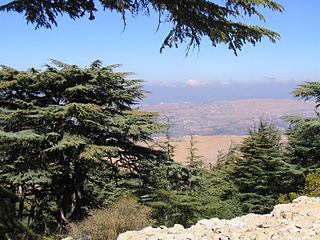
Cedrus, common English name cedar, is a genus of coniferous trees in the plant family Pinaceae. They are native to the mountains of the western Himalayas and the Mediterranean region, occurring at altitudes of 1,500–3,200 m in the Himalayas and 1,000–2,200 m in the Mediterranean.

Firs are evergreen coniferous trees belonging to the genus Abies in the family Pinaceae. There are approximately 48–56 extant species, found on mountains throughout much of North and Central America, Europe, Asia, and North Africa. The genus is most closely related to Cedrus (cedar).

The gymnosperms are a group of seed-producing plants that includes conifers, cycads, Ginkgo, and gnetophytes, forming the clade Gymnospermae. The term gymnosperm comes from the composite word in Greek: γυμνόσπερμος, literally meaning 'naked seeds'. The name is based on the unenclosed condition of their seeds. The non-encased condition of their seeds contrasts with the seeds and ovules of flowering plants (angiosperms), which are enclosed within an ovary. Gymnosperm seeds develop either on the surface of scales or leaves, which are often modified to form cones, or on their own as in yew, Torreya, Ginkgo. Gymnosperm lifecycles involve alternation of generations. They have a dominant diploid sporophyte phase and a reduced haploid gametophyte phase which is dependent on the sporophytic phase. The term "gymnosperm" is often used in paleobotany to refer to all non-angiosperm seed plants. In that case, to specify the modern monophyletic group of gymnosperms, the term Acrogymnospermae is sometimes used.

The Pinaceae, or pine family, are conifer trees or shrubs, including many of the well-known conifers of commercial importance such as cedars, firs, hemlocks, larches, pines and spruces. The family is included in the order Pinales, formerly known as Coniferales. Pinaceae are supported as monophyletic by their protein-type sieve cell plastids, pattern of proembryogeny, and lack of bioflavonoids. They are the largest extant conifer family in species diversity, with between 220 and 250 species in 11 genera, and the second-largest in geographical range, found in most of the Northern Hemisphere, with the majority of the species in temperate climates, but ranging from subarctic to tropical. The family often forms the dominant component of boreal, coastal, and montane forests. One species, Pinus merkusii, grows just south of the equator in Southeast Asia. Major centres of diversity are found in the mountains of southwest China, Mexico, central Japan, and California.

Araucaria is a genus of evergreen coniferous trees in the family Araucariaceae. There are 20 extant species in New Caledonia, Norfolk Island, eastern Australia, New Guinea, East Argentina, South Brazil, Chile and Paraguay. They are still common in the South Pacific region and Eastern Australia.
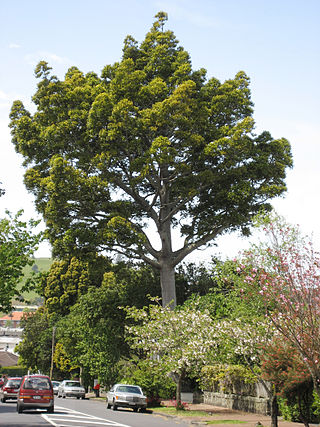
Agathis, commonly known as kauri or dammara, is a genus of 22 species of evergreen tree. The genus is part of the ancient conifer family Araucariaceae, a group once widespread during the Jurassic and Cretaceous periods, but now largely restricted to the Southern Hemisphere except for a number of extant Malesian Agathis.
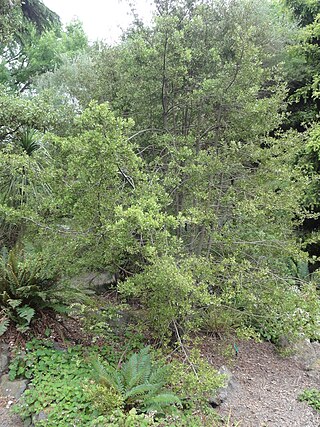
Phyllocladus, the celery pines, is a small genus of conifers, now usually treated in the family Podocarpaceae.Species occur mainly in New Zealand, Tasmania, and Malesia in the Southern Hemisphere, though P. hypophyllus ranges into the Philippines, a short way north of the equator.

Gnetum is a genus of gymnosperms, the sole genus in the family Gnetaceae within the Gnetophyta. They are tropical evergreen trees, shrubs and lianas. Unlike other gymnosperms, they possess vessel elements in the xylem. Some species have been proposed to have been the first plants to be insect-pollinated as their fossils occur in association with extinct pollinating scorpionflies. Molecular phylogenies based on nuclear and plastid sequences from most of the species indicate hybridization among some of the Southeast Asian species. Fossil-calibrated molecular-clocks suggest that the Gnetum lineages now found in Africa, South America and Southeast Asia are the result of ancient long-distance dispersal across seawater.
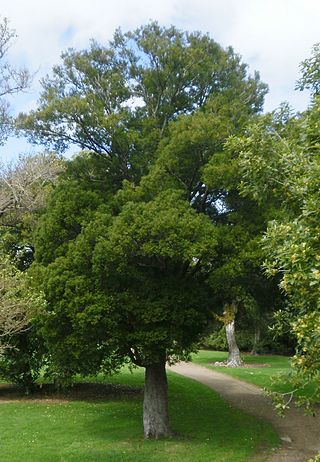
Prumnopitys is a genus of conifers belonging to the family Podocarpaceae. The nine recognized species of Prumnopitys are densely branched, dioecious evergreen trees up to 40 metres in height.

Halocarpus is a genus of conifers of the family Podocarpaceae. The genus includes three closely related species of evergreen trees and shrubs, all endemic to New Zealand.
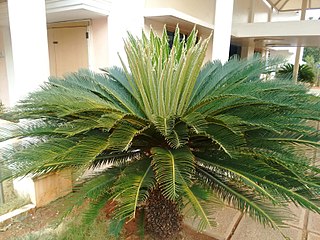
Cycas is a genus of cycad, and the only genus in the family Cycadaceae. About 113 species are accepted, which are native to the Asia-Pacific, East Africa and Madagascar. Cycas circinalis, a species endemic to India, was the first cycad species to be described in western literature, and is the type species of the genus. The best-known Cycas species is Cycas revoluta.

Zamia is a genus of cycad of the family Zamiaceae, native to North America from the United States throughout the West Indies, Central America, and South America as far south as Bolivia. The genus is considered to be the most ecologically and morphologically diverse cycads, and is estimated to have originated about 68.3 million years ago.

Keteleeria is a genus of three species of coniferous trees in the family Pinaceae first described as a genus in 1866.

Macrozamia is a genus of around forty species of cycads, family Zamiaceae, all of which are endemic to Australia. Many parts of the plant have been utilised for food and material, most of which is toxic if not processed correctly.

Encephalartos is a genus of cycad native to Africa. Several species of Encephalartos are commonly referred to as bread trees, bread palms or kaffir bread, since a bread-like starchy food can be prepared from the centre of the stem. The genus name is derived from the Greek words en (within), kephalē (head), and artos (bread), referring to the use of the pith to make food. They are, in evolutionary terms, some of the most primitive living gymnosperms.
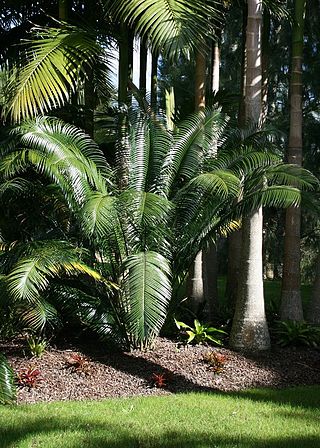
Lepidozamia is a genus of two species of cycad, both endemic to Australia. They are native to rainforest climates in eastern Queensland and eastern New South Wales. They have a diploid chromosome number of 2n = 18.
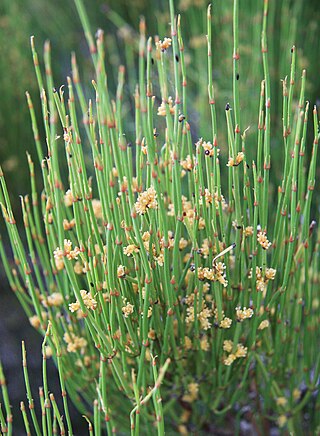
Ephedra is a genus of gymnosperm shrubs. The various species of Ephedra are widespread in many arid regions of the world, ranging across southwestern North America, southern Europe, northern Africa, southwest and central Asia, northern China and western South America. It is the only extant genus in its family, Ephedraceae, and order, Ephedrales, and one of the three living members of the division Gnetophyta alongside Gnetum and Welwitschia.
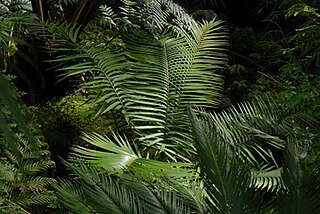
Ceratozamia is a genus of New World cycads in the family Zamiaceae. The genus contains 27 known currently living species and one or two fossil species. Most species are endemic to mountainous areas of Mexico, while few species extend into the mountains of Guatemala, Honduras and Belize. The genus name comes from the Greek ceras, meaning horn, which refers to the paired, spreading horny projections on the male and female sporophylls of all species.




















